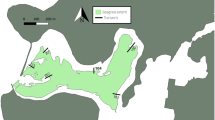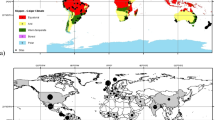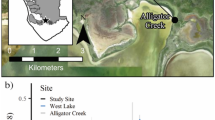Abstract
Nitrogen inputs restructure ecosystems and can interact with other agents of ecological change and potentially intensify them. To examine the effects of nitrogen combined with those of elevation and competition, in 2005 we mapped vegetation and elevation within experimental plots that have been fertilized since 1970 in Great Sippewissett salt marsh, Cape Cod, MA, USA and compared the resulting effects on marsh vegetation. Decadal-scale chronic nutrient enrichment forced changes in cover and spatial distribution of different species. With increasing enrichment, there was a shift in species cover primarily involving loss of Spartina alterniflora and an increase in Distichlis spicata. Percent cover of near monocultures increased with nitrogen fertilization, owing mainly to the proliferation of D. spicata. The experimental fertilization prompted a shift from the short form of S. alterniflora to taller forms, hence increasing above-ground biomass, where this species managed to remain. Chronic enrichment increased upper and lower limits of the elevation range within which certain species occurred. The shift to increased cover of D. spicata was also associated with faster accretion of the marsh surface where this species was dominant, but not where S. alterniflora was dominant. Interactions among nutrient supply, elevation, and competition altered the direction of competitive success among different species of marsh plants, and forced changes in the spatial distribution and composition of the salt marsh plant communities. The results imply that there will be parallel changes in New England salt marshes owing to the widespread eutrophication of coastal waters and the increasing sea level rise. Knowing the mechanisms structuring marsh vegetative cover, and their role in modification of salt marsh accretion, may provide background with which to manage maintenance of affected coastal wetlands.












Similar content being viewed by others
References
Bertness, M.D. 1988. Peat accumulation and the success of marsh plants. Ecology 69: 703–713.
Bertness, M.D. 1991a. Zonation of Spartina patens and Spartina alterniflora in a New England salt marsh. Ecology 72: 138–148.
Bertness, M.D. 1991b. Interspecific interactions among high marsh perennials in a New England salt marsh. Ecology 72: 125–137.
Bertness, M.D., and A.M. Ellison. 1987. Determinants of pattern in a New England salt marsh plant community. Ecological Monographs 57: 129–147.
Bertness, M.D., K. Wikler, and T. Chatkupt. 1992. Flood tolerance and the distribution of Iva frutescens across New England salt marshes. Oecologia 91: 171–178.
Bianchi, T.S. 2007. Biogeochemistry of estuaries. New York, NY: Oxford University Press.
Bockelman, A.C., J.P. Bakker, R. Neuhaus, and J. Lage. 2002. The relation between vegetation zonation, elevation and inundation frequency in Wadden Sea salt marsh. Aquatic Botany 73: 211–221.
Bricker, S.B. 1999. National estuarine eutrophication assessment: effect of nutrient enrichment in the nation’s estuaries. U.S. Dept. of Commerce, National Oceanic and Atmospheric Administration, National Ocean Service, Special Projects Office: National Centers for Coastal Ocean Science.
Chalmers, A.G. 1979. The effects of fertilization on nitrogen distribution in a Spartina alterniflora salt marsh. Estuarine and Coastal Marine Science 8: 327–337.
Chapman, V.J. 1960. Salt marshes and salt deserts of the world. New York: Interscience.
Cherry, J.A., K.L. McKee, and J.B. Grace. 2009. Elevated CO2 enhances biological contributions to elevation change in coastal wetlands by offsetting stressors associated with sea-level rise. Journal of Ecology 97: 67–77.
Darby, F.A., and R.E. Turner. 2008. Effects of eutrophication on salt marsh root and rhizome biomass accumulation. Marine Ecology Progress Series 363: 63–70.
Donnelly, J.P., and M.D. Bertness. 2001. Rapid shoreward encroachment of salt marsh cordgrass in response to accelerated sea-level rise. Proceedings of the National Academy of Sciences USA 98: 14218–14223.
Evgenidou, A., and I. Valiela. 2002. Response of growth and density of a population of Geukensia demissa to land-derived nitrogen loading in Waquoit Bay, Massachusetts. Estuarine, and Coastal and Shelf Marine Science 55: 125–138.
Fox, L. 2007. Long-term changes in salt marsh vegetation: Effects of chronic nutrient enrichment and sea-level rise. M.A. Thesis, Boston University.
Gallagher, J.L., G.F. Somers, D.M. Grant, and D.M. Seliskar. 1988. Persistent differences in two forms of Spartina alterniflora: A common garden experiment. Ecology 69: 1005–1008.
Gehrels, W.R., J.R. Kirby, A. Prokoph, R.M. Newnham, E.P. Achterberg, H. Evans, S. Black, and D.B. Scott. 2005. Onset of recent rapid sea-level rise in the western Atlantic Ocean. Quaternary Science Reviews 24: 2083–2100.
Giblin, A.E., G.W. Luther III, and I. Valiela. 1986. Trace metal solubility in salt marsh sediments containing sewage sludge. Estuarine, Coastal and Shelf Science 23: 477–498.
Haines, E.B. 1979. Growth dynamics of cordgrass, Spartina alterniflora Loisel., on control and sewage sludge fertilized plots in a Georgia salt marsh. Estuaries 2: 50–53.
Hersh, D. A. 1996. Abundance and distribution of intertidal and subtidal macrophytes in Cape Cod: the role of nutrient supply and other controls. Ph.D. Thesis, Boston University.
Howes, B.L., R.W. Howarth, J.M. Teal, and I. Valiela. 1981. Oxidation reduction potentials in a salt marsh: Spatial patterns and interactions with primary production. Limnology and Oceanography 26: 350–360.
Howes, B.L., J.W.H. Dacey, and D.D. Goehringer. 1986. Factors controlling the growth form of Spartina alterniflora: Feedbacks between above-ground production, sediment oxidation, nitrogen and salinity. Journal of Ecology 74: 881–898.
Kinney, E. L. 2010. Experimental and regional studies of sources of nitrogen using models and stable isotopes in salt marshes. Ph.D. Thesis, Boston University.
Langley, J.A., K.L. McKee, D.R. Cahoon, J.A. Cherry, and J.P. Megonigal. 2009. Elevated CO2 stimulates marsh elevation gain, counterbalancing sea-level rise. Proceedings of the National Academy of Sciences 106: 6182–6186.
Levine, J.M., J.S. Brewer, and M.D. Bertness. 1998a. Nutrients, competition and plant zonation in a New England salt marsh. Journal of Ecology 86: 285–292.
Levine, J.M., S.D. Hacker, C.D.G. Harley, and M.D. Bertness. 1998b. Nitrogen effects on an interaction chain in a salt marsh community. Oecologia 117: 266–272.
McKee, K.L., D.R. Cahoon, and I.C. Feller. 2007. Caribbean mangroves adjust to rising sea-level through biotic controls on change in soil elevation. Global Ecology and Biogeography 16: 545–556.
Morris, J.T., P.V. Sundareshwar, C.T. Nietch, B. Kjerfve, and D.R. Cahoon. 2002. Responses of coastal wetlands to rising sea level. Ecology 83: 2869–2877.
Mueller-Dombois, D., and H. Ellenberg. 1974. Aims and methods of vegetation ecology. New York: Wiley.
Ornes, W.H., K.S. Sajwan, B.G. Loganathan, and C.S. Chetty. 1998. Comparison of selected element concentrations in tall and short forms of Spartina alterniflora. Marine Pollution Bulletin 36: 390–395.
Pennings, S.C., E.R. Selig, L.T. Houser, and M.D. Bertness. 2003. Geographic variation in positive and negative interactions among salt marsh plants. Ecology 84: 1527–1538.
Pennings, S.C., M.B. Grant, and M.D. Bertness. 2005. Plant zonation in low-latitude salt marshes: Disentangling the roles of flooding, salinity and competition. Journal of Ecology 93: 159–167.
Portnoy, J.W., and I. Valiela. 1997. Short-term effects of salinity reduction and drainage on salt-marsh biogeochemical cycling and Spartina (cordgrass) production. Estuaries 20: 569–578.
Reddy, C.M., T.I. Eglinton, A. Hounshell, H.K. White, L. Xu, R.B. Gaines, and G.S. Frysinger. 2002. The West Falmouth oil spill after thirty years: The persistence of petroleum hydrocarbons in marsh sediments. Environmental Science and Technology 36: 4754–4760.
Redfield, A.C. 1972. Development of a New England salt marsh. Ecological Monographs 42: 201–237.
Reed, D.J. 2002. Sea-level rise and coastal marsh sustainability: Geological and ecological factors in the Mississippi Delta Plain. Geomorphology 48: 233–243.
Rietsma, C.S., R.O. Monteiro, and I. Valiela. 2011. Plant cover, herbivory, and resiliency in a Cape Cod salt marsh: Multi-year responses and recovery following manipulation of nutrients and competition. Estuaries and Coasts 34: 198–210.
Rogers, J., J. Harris, and I. Valiela. 1998. Interaction of nitrogen supply, sea level rise, and elevation on species form and composition of salt marsh plants. The Biological Bulletin 195: 235–237.
Seliskar, D.M., J.L. Gallagher, D.M. Burdick, and L.A. Mutz. 2002. The regulation of ecosystem function by ecotypic variation in the dominant plant: A Spartina alterniflora salt marsh case study. Journal of Ecology 90: 1–11.
Shea, M.L., R.S. Warren, and W.A. Niering. 1975. Biochemical and transplantation studies of the growth form of Spartina alterniflora on Connecticut salt marshes. Ecology 56: 461–466.
Silvestri, S., A. Defina, and M. Marani. 2005. Tidal regime, salinity and salt marsh plant zonation. Estuarine, Coastal and Shelf Science 62: 119–130.
Slocum, M.G., I.A. Mendelssohn, and N.L. Kuhn. 2005. Effects of sediment slurry enrichment on salt marsh rehabilitation: Plant and soil responses over seven years. Estuaries 28: 519–528.
Suding, K.N., S.L. Collins, L. Gough, C. Clark, E.E. Cleland, K.L. Gross, D.G. Milchunas, and S. Pennings. 2005. Functional- and abundance-based mechanisms explain diversity loss due to N fertilization. Proceedings of the National Academy of Sciences 102: 4387–4392.
Sullivan, M.J., and F.C. Daiber. 1974. Response in production of cordgrass, Spartina alterniflora, to inorganic nitrogen and phosphorus fertilizer. Chesapeake Science 15: 121–123.
Thursby, G.B., and M.A. Abdelrhman. 2004. Growth of the marsh elder Iva frutescens in relation to duration of tidal flooding. Estuaries 27: 217–224.
Traut, B.H. 2005. Effects of nitrogen addition and salt grass (Distichlis spicata) upon high salt marsh vegetation in Northern California, USA. Estuaries 28: 286–295.
Turner, R.E., B.L. Howes, J.M. Teal, C.S. Milan, E.M. Swenson, and D.D. Goehringer-Toner. 2009. Salt marshes and eutrophication: An unsustainable outcome. Limnology and Oceanography 54: 1634–1642.
Valiela, I. 2005. Global coastal change. Malden, MA: Blackwell.
Valiela, I., and C.S. Rietsma. 1995. Disturbance of salt marsh vegetation by wrack mats in Great Sippewissett Marsh. Oecologia 102: 106–112.
Valiela, I., and J.M. Teal. 1974. Nutrient limitation in salt marsh vegetation. In Ecology and halophytes, ed. R.J. Reimold of W.H. Queen, 547–563. New York: Academic Press.
Valiela, I., J.M. Teal, and W.J. Sass. 1973. Production and dynamics of salt marsh vegetation and the effects of experimental treatment with sewage sludge: Biomass, production and species composition. Journal of Applied Ecology 12: 973–981.
Valiela, I., J.M. Teal, and W.J. Sass. 1975. Production and dynamics of experimentally enriched salt marsh vegetation: Above ground biomass. Limnology and Oceanography 21: 245–252.
Valiela, I., J.M. Teal, and N.Y. Persson. 1976. Production and dynamics of experimentally enriched salt marsh vegetation: Belowground biomass. Limnology and Oceanography 21: 245–252.
Valiela, I.J.M., Teal, and W.G. Deuser. 1978. The nature of growth forms in the salt marsh grass Spartina alterniflora. The American Naturalist 112: 461–470.
Valiela, I., J.M. Teal, C. Cogswell, J. Hartman, S. Allen, R. Van Ettern, and D. Goehringer. 1985a. Some long-term consequences of sewage contamination in salt marsh ecosystems. In Ecological considerations in wetlands treatment of municipal wastewaters, ed. P.J. Godfrey, E.R. Kaynor, S. Pelczarski, and J. Benforado, 301–316. New York: Van Nostrand Reinhold.
Valiela, I., J.M. Teal, S.D. Allen, R. Van Etten, D. Goehringer, and S. Volksmann. 1985b. Decomposition in salt marsh ecosystems: The phases and major factors affecting disappearance of above-ground organic matter. Journal of Experimental Marine Biology and Ecology 89: 29–54.
Warren, R.S., and W.A. Niering. 1993. Vegetation change on a northeast tidal marsh: Interaction of sea-level rise and marsh accretion. Ecology 74: 96–103.
White, H.K., C.M. Reddy, and T.I. Eglinton. 2005a. Isotopic constraints on the fate of petroleum residues sequestered in salt marsh sediments. Environmental Science and Technology 39: 2545–2551.
White, H.K., L. Xu, A.L.C. Lima, T.I. Eglinton, and C.M. Reddy. 2005b. Abundance, composition and vertical transport of PAHs in marsh sediments. Environmental Science and Technology 39: 8273–8280.
Acknowledgments
In a project with a history of several decades, many people, agencies, and institutions made essential contributions. The owners of salt marsh parcels in Great Sippewissett marsh, the Arnold Gifford family during the early years, and more recently the Edward Hughes family, as well as Salt Pond Inc., and the Massachusetts Audubon Society, have been exceedingly forward-looking, helpful, and accommodating by allowing us to establish and maintain the experimental plots within their properties. We are indebted to many colleagues that shared the work and aims for the many decades behind this effort. Foremost, we thank John Teal, who steadfastedly made us focus on important aspects during the early decades of the Great Sippewissett salt marsh project. We owe a substantial debt to Brian Howes and Dale Goehringer and their students at the School of Marine Sciences and Technology, University of Massachusetts, Dartmouth, for their continuing efforts in maintaining the experimental plots. We also thank Carley Schacter for assistance in the field, and Daniel Steinberg, Frederic Jaffre, and Alfredo Aretxabaleta for help with ArcGIS and Matlab. This work was supported, over the years, by many private and federal sources, of which we here only note NSF grants DEB-0516430, DEB-0914795, and OCE-0453292, and NOAA grant NA07NOS4200025 to IV.
Author information
Authors and Affiliations
Corresponding author
Rights and permissions
About this article
Cite this article
Fox, L., Valiela, I. & Kinney, E.L. Vegetation Cover and Elevation in Long-Term Experimental Nutrient-Enrichment Plots in Great Sippewissett Salt Marsh, Cape Cod, Massachusetts: Implications for Eutrophication and Sea Level rise. Estuaries and Coasts 35, 445–458 (2012). https://doi.org/10.1007/s12237-012-9479-x
Received:
Revised:
Accepted:
Published:
Issue Date:
DOI: https://doi.org/10.1007/s12237-012-9479-x




